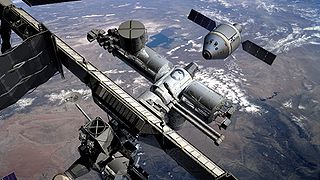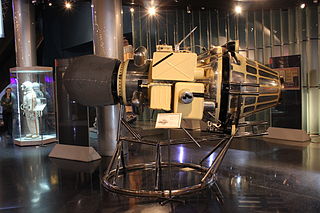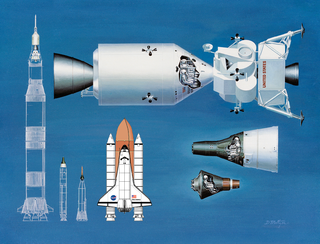 W
WThe Apollo program was the third United States human spaceflight program carried out by the National Aeronautics and Space Administration (NASA), which accomplished landing the first humans on the Moon from 1969 to 1972. During the Apollo 11 mission, astronauts Neil Armstrong and Buzz Aldrin landed their Apollo Lunar Module (LM) and walked on the lunar surface, while Michael Collins remained in lunar orbit in the command and service module (CSM), and all three landed safely on Earth on July 24, 1969. Five subsequent Apollo missions also landed astronauts on the Moon, the last in December 1972. In these six spaceflights, twelve men walked on the Moon.
 W
WThe Artemis program is a human spaceflight program by the United States. Missions in the program are aimed at exploration of the Moon, including crewed and robotic exploration of the lunar surface. Three flights of the Orion Multi-Purpose Crew Vehicle are currently planned for launch in the Artemis program in the early 2020s, beginning with Artemis 1. Before Artemis was named, the flights were referred to as "Orion missions". Numerous supporting scientific and technology demonstration missions are planned for launch under the program's Commercial Lunar Payload Services, in addition to planned and proposed uncrewed logistical missions to construct and resupply the Lunar Gateway and its expendable and reusable lunar landers in lunar orbit.
 W
WThe Buran programme was an attempt by the Soviet Union to construct an orbital spaceplane to perform similar functions to the Space Shuttle. Similar to the Space Shuttle programme, an aerodynamic prototype and a number of operational spacecraft were planned for the Buran programme, which were known as "Buran-class orbiters".
 W
WThe Constellation Program was NASA's planned future human spaceflight program between 2005 and 2009, which aimed to develop a new crewed spacecraft (Orion) and a pair of launchers to continue servicing the International Space Station and return to the Moon.
 W
WUncrewed spaceflights to the International Space Station (ISS) are made primarily to deliver cargo, however several Russian modules have also docked to the outpost following uncrewed launches. Resupply missions typically use the Russian Progress spacecraft, European Automated Transfer Vehicles, Japanese Kounotori vehicles, and the American Dragon and Cygnus spacecraft. The primary docking system for Progress spacecraft is the automated Kurs system, with the manual TORU system as a backup. ATVs also use Kurs, however they are not equipped with TORU. Progress and ATV can remain docked for up to six months. The other spacecraft — the Japanese HTV, the SpaceX Dragon and the Northrop Grumman Cygnus — rendezvous with the station before being grappled using Canadarm2 and berthed at the nadir port of the Harmony or Unity module for one to two months. Under CRS phase 2, Cargo Dragon will dock autonomously at IDA-2 or 3 as the case may be. As of January 2021, Progress spacecraft have flown most of the uncrewed missions to the ISS.
 W
WAs part of human exploration of the Moon, numerous space missions have been undertaken to study Earth's natural satellite. Of the Moon landings, Luna 2 of the Soviet Union was the first spacecraft to reach its surface successfully, intentionally impacting the Moon on 13 September 1959. In 1966, Luna 9 became the first spacecraft to achieve a controlled soft landing, while Luna 10 became the first mission to enter orbit.
 W
WThis is a list of NASA missions, both crewed and robotic, since its establishment in 1958.
 W
WThis is a list of missions conducted by Progress automated spacecraft. Progress is an uncrewed Russian cargo spacecraft which has been used since 1978 to deliver supplies to Soviet space stations Salyut 6, Salyut 7, Mir, and later to the International Space Station. All launches have occurred from the Baikonur Cosmodrome.
 W
WThe Space Shuttle was a partially reusable low Earth orbital spacecraft system operated by the National Aeronautics and Space Administration (NASA). Its official program name was Space Transportation System (STS), taken from a 1969 plan for a system of reusable spacecraft of which it was the only item funded for development. Operational missions launched numerous satellites, conducted science experiments in orbit, and participated in construction and servicing of the International Space Station (ISS). The first of four orbital test flights occurred in 1981, leading to operational flights beginning in 1982.
 W
WA number of space tethers have been deployed in space missions. Tether satellites can be used for various purposes including research into tether propulsion, tidal stabilisation and orbital plasma dynamics.